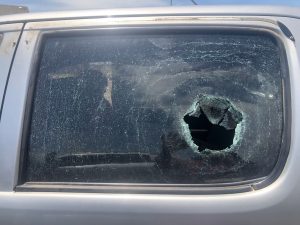Kenya’s Deputy President William Ruto’s campaign tour turned violent after a mob hurled rocks at his motorcade in Kondele, Kisumu County.
The DP, who yesterday began his visit of Nyanza region, the heart of ODM leader Raila Odinga’s backyard, is on a tour to popularise his bid for the presidency.
The Wednesday afternoon chaos forced Dr Ruto who was addressing the crowd from his vehicle’s sunroof to cut short his speech amid heckling and stones.
His security detail was forced to climb atop the bonnet of his official vehicle to protect him from the stones, with a few people dramatically clinging to his car as police fired teargas cannisters to quel the rowdy youths.
Ruto managed to leave the scene unhurt, but with a few vehicles damaged. He condemned the stone-throwing, saying his presidency will engage the youth in more meaningful activities.
In a statement issued hours after the chaos, police said some cars were destroyed in the chaos but no injuries were reported.

Police also noted that they had earlier received intelligence that there would be trouble in Kondele amid growing tensions.
“This intelligence was promptly shared with H.E the Deputy President’s team with a recommendation to skip the affected area during the tour…During the rally, violence erupted amongst the local agitated groups who engaged in stone-throwing and other unruly behaviour,” read part of the statement signed by Police.
Police Spokesperson Bruno Shioso adds that the intelligence gathered by security agencies indicated that “there was tension within Kondele owing to alleged distribution of campaign logistical funds amongst local groups”.
In a tweet following the incident, Ruto said: “The hustle nation dissasociates with leaders and political groupings who use violence to advance their selfish cause. Our plans and programmes will ensure that the youths are liberated from regressive stone-throwing culture by engaging them in gainful activities that will better their lives through Bottom-up Economic Model”